James Maliszewski's Blog, page 81
March 22, 2023
Retrospective: The Final Enemy
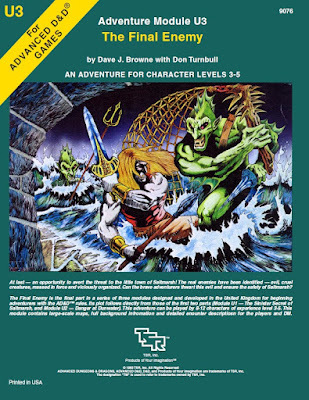 Published in 1983, The Final Enemy is the conclusion of the trilogy of AD&D adventure modules that began with The Sinister Secret of Saltmarsh and continued in Danger at Dunwater. Like both its predecessors, module U3 was written by Dave J. Browne with assistance from Don Turnbull. This authorial continuity is important, lending a consistency of content and tone to the three modules that was missing in, for example, the slightly earlier Slave Lords series (though, to be fair, the latter were originally written for tournament use).
Published in 1983, The Final Enemy is the conclusion of the trilogy of AD&D adventure modules that began with The Sinister Secret of Saltmarsh and continued in Danger at Dunwater. Like both its predecessors, module U3 was written by Dave J. Browne with assistance from Don Turnbull. This authorial continuity is important, lending a consistency of content and tone to the three modules that was missing in, for example, the slightly earlier Slave Lords series (though, to be fair, the latter were originally written for tournament use). Unfortunately, this consistency does not extend to the module's artwork. Whereas Saltmarsh and Dunwater featured some excellent illustrations by James Holloway and Harry Quinn, The Final Enemy includes some of the least attractive artwork Keith Parkinson ever produced, which gives the whole thing a drab, uninspiring feel. That's too bad, because, like the other adventures in the series, module U3 possesses some unique elements that set it apart from the AD&D adventures of its time.
The Secret of Saltmarsh was, at base, a mystery. Meanwhile, Danger at Dunwater focused on reconnaissance and diplomacy. The Final Enemy also includes a significant reconnaissance element, as the player characters, aided by up to 20 NPCs, scout out the sahuagin fortress in preparation for the main part of the scenario – an all-out assault on the fortress of the evil underwater humanoids. That assault forms the bulk of the module's content, with lots of attention given to the fortress, its many inhabitants, and their tactics in defending their lair. The whole affair has, in my opinion, a very naturalistic cast to it, with the sahuagin behaving in a rational manner in response to a combined attack by the PCs, the people of the town of Saltmarsh, and their lizard men allies (assuming they were successful in forging an alliance with them in Danger at Dunwater).
One might reasonably question whether a military-style assault against evil humanoids genuinely offers anything we haven't seen many times before in Dungeons & Dragons. The very first AD&D module ever published featured something in a similar vein and many of the scenarios that followed in its considerable wake followed its pattern. What distinguishes The Final Enemy from its forebears is its attention to planning and preparation, not to mention the additional forces the PCs can bring to bear in their efforts. Remember that this module is intended for use with characters of levels 3–5, which is still well within the level range where PCs can easily die if they are not careful.
This is a fact the module mentions several times, starting with its introduction:
The DM must recognise from the outset that this is a very dangerous module for the characters. Play-testing has shown that the mission can be accomplished by a courageous, thoughtful party whose members have planned their incursion into the fortress carefully. Equally, play-testing has demonstrated that careless players who fail to plan ahead can quickly land their characters in serious trouble, in which case those characters are fortunate if they are able to escape from the fortress area alive.
Similar warnings are found throughout the text and rightly so. The Final Enemy could indeed be called a military-style adventure with plenty of opportunities for combat against monstrous foes. Despite that, it is not a hack-and-slash adventure and appropriately-leveled characters who behave as if it were will soon find themselves dead. Instead, players are well advised to make good use of their reconnaissance and allies to defeat the sahuagin through equal parts ingenuity and boldness.
There's an additional aspect of this module that sets it apart from its contemporaries, as well as contributing to its potential danger to the unprepared. Much of the sahuagin fortress is underwater, meaning that the player characters and many of their allies will be at a disadvantage when fighting unless they take precautions. These precautions come in many forms, including magic items and spells that enable the PCs to breathe water, but few are easily obtainable without making full use of reconnaissance and, in one case, thoughtful interaction with a potentially friendly NPC. Underwater adventures are rare, so many players will not have much experience with their niceties. The Final Enemy makes good use of this fact to present a memorable and quite challenging adventure, one that's fun in its own right and as a satisfying conclusion to the entire U-series of modules.
March 21, 2023
White Dwarf: Issue #68
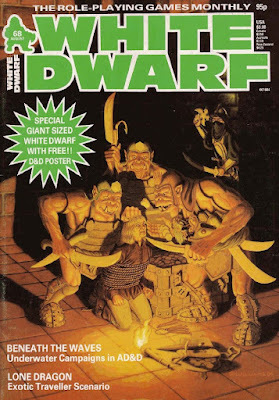 Issue #68 of White Dwarf (August 1985) features a cover by Brian Williams, who's probably best known for his work on the Lone Wolf series (though he also produced covers for both Games Workshop and TSR UK). For me, the issue marks the first one in several years when I was not a subscriber. I still picked up copies from time to time, but I was inconsistent in doing so. Consequently, many of the issues that I'll look at in the coming weeks are ones I didn't see at the time of their original publication or that, in some cases, I never read at all.
Issue #68 of White Dwarf (August 1985) features a cover by Brian Williams, who's probably best known for his work on the Lone Wolf series (though he also produced covers for both Games Workshop and TSR UK). For me, the issue marks the first one in several years when I was not a subscriber. I still picked up copies from time to time, but I was inconsistent in doing so. Consequently, many of the issues that I'll look at in the coming weeks are ones I didn't see at the time of their original publication or that, in some cases, I never read at all.In his editorial, Ian Livingstone theorizes, based on reader feedback, that the readership of White Dwarf is in the vicinity of 100,000. That seems implausibly high to me, especially for mid-1985, but I must confess I've never had a good sense of the actual size of the hobby. Livingstone states that "our hobby is growing fast" and I can only presume he had better information on this than I ever have. Regardless, I always find it fascinating to ponder the size and growth of the hobby over the decades and this is yet another data point to consider.
"The Artificer" by David Marsh is a new character class for use with AD&D. As its name suggests, the class focuses on the construction and use of mechanisms of various sorts. Unfortunately, as presented, the class is simply a spellcaster with a unique (and very focused) spell list and some thief abilities thrown in. While I can understand why this approach was taken, it's disappointing to me. I've long wanted an artificer (and alchemist) class that was genuinely different in its presentation and not simply a magic-user or cleric with some unusual spells. Oh well.
"Open Box" very favorably reviews Blood Bath at Orcs Drift (9 out of 10), a scenario for use with Warhammer Fantasy Battle. Also reviewed are Dragon Roar (5 out of 10), the computer game Chaos (7 out of 10), Legacy of Eagles (7 out of 10), an adventure for Golden Heroes; and The Worlds of Boris Vallejo boardgame (3 out of 10). From my perspective, though, the most notable review is Marcus Rowland's harsh one of Twilight: 2000 (5 out of 10). Rowland's many criticisms are not for the rules themselves but for the game's basic set-up and "moral stance and attitudes," which he calls "fairly loathsome." By and large, he seems to find the idea of the aftermath of a limited-nuclear World War III an unfit subject for a roleplaying game, "one written for and by Americans, with little or no understanding of European attitudes or desires."
Dave Langford's "Critical Mass" continues to do what it always does: briefly – and snarkily – review science fiction and fantasy novels from the '80s that I either never read or don't remember, with a handful of exceptions here and there. He also continues to take potshots at L. Ron Hubbard's Battlefield Earth, which I can't really criticize but neither can I applaud it, since it's a bit like shooting fish in a barrel. Meanwhile, "Free the Spirit" presents two new additions for use with Call of Cthulhu, both of which are add-ons to the excellent "Haunters of the Dark" article from last issue: the clergyman profession and the hypnotism skill. Sadly, neither of these expansions are as good (or useful) as the original article.
"Beneath the Waves" by Peter Blanchard is the promising start of a series dedicated to aquatic adventures in AD&D. Blanchard begins by looking at the nature of the underwater environment, including how it affects one's movement and senses, as well as the need for some means of breathing. I give the article bonus points for referencing the 1960s anime, Marine Boy, which I strangely loved as a young child. I definitely look forward to future installments in the series, since underwater adventures have long held my imagination, even though (because?) I've largely never managed to make them work as well as I would have liked.
"Solo Series" by Simon Burley looks at the ins and outs solo adventuring in a superhero RPG. It's a very good overview of this topic, one made all the better in my opinion due to the prevalence of lone heroes in the superhero genre. "Lone Dragon" by Phil Masters is a lengthy but well-done scenario for Traveller that makes use of both Mercenary and Striker. The characters are hired by a mysterious "nobleman" from a nearby world that has fallen into political and civil unrest for what he presents as a quick smash-and-grab mission in search of wealth. Naturally, things are quite as simple as that.
Speaking of Traveller, "The Travellers" comic begins a series of presenting its characters in game terms, starting with Captain Horatio Flinn and his sometime love interest Syrena Medussa. I'm a sucker for things like this, especially when, as in this case, the author understands the RPG system in question and uses it to humorous effect. The issue also includes further installments of "Thrud the Barbarian" and "Gobbledigook." In the former, writer/artist Carl Critchlow once again appears, this time as the narrator delivering useful exposition.
I mentioned above how disappointed I was with the artificer class, right? Interestingly, the issue includes a very clever adventure by the same author, intended to highlight the utility of the class and its role in AD&D. Entitled "Star of Darkness" the scenario tackles the old trope of technology vs magic but does so in an intriguing and flavorful setting, complete with lots of maps, NPCs, and challenges. I did not expect to like this as much as I did, but it's an imaginative and fun little adventure for characters of levels 3–4.
"Words of Wonder" is a collection of new AD&D spells of varying utility, which is the usual pattern with articles of this type. "The Magic Frame" by Joe Dever continues to explore the question of photographing miniatures, with lots of thoughts on approaches and techniques. Dever's columns in White Dwarf continue to be my favorites, in spite of my own relative inexperience with miniatures. He clearly has a passion for the subject, not to mention remarkable skills, and he manages to convey both through his words and photos. As ever, I find myself wishing I'd devoted myself to this aspect of the hobby when I was younger and in a better position to acquire some skills of my own.
March 14, 2023
Vance on CAS and HPL
A comment to yesterday's post reminded me of a longstanding mystery: the influence, if any, of the works of Clark Ashton Smith on those of Jack Vance. Purely on the basis of subject matter and style, I'd long assumed that Vance's tales of The Dying Earth had been influenced by Smith's own tales of Zothique. I eventually read something – I cannot recall precisely where – that addressed the matter, claiming that Vance had not in fact read Smith and, therefore, any resemblance between the two mordantly witty writers was purely coincidental.
The aforementioned comment, however, spurred me to look into the question once again. In doing so, I discovered a new piece of information, new to me at any rate. The May 2005 issue of Cosmopolis reprints an old interview with Jack Vance from September 1981. The interview is fascinating for a number of reasons, but it's what Vance has to say about Clark Ashton Smith (and H.P. Lovecraft) that is of most immediate interest. The relevant section begins with the interviewer, Charles Platt, referencing Smith:
I mention that Don Herron, a critic who contributed to a symposium on Vance, deduced that Vance had been heavily influenced by the work of Clark Ashton Smith.
"I was one of those precocious, highly intelligent kids, old beyond my years. I had lots of brothers and sisters, but I was isolated from them in a certain kind of way. I just read and read and read. One of the things I read was the old Weird Tales pulp magazine, which published Clark Ashton Smith. He was one of the generative geniuses of fantasy. The others, Lovecraft, for instance, were ridiculous. Lovecraft couldn't write his way out of a wet paper sack. Smith is a little clumsy at times, but at least his prose is always readable.
"When I wrote my first fantasies, I was no longer aware of Smith – it had sunk so far into my subconscious. But when it was pointed out to me, I could very readily see the influence."
Leaving aside Vance's, I think, unfairly harsh assessment of Lovecraft, I find it strangely vindicating to see him admit to the influence of Smith on his own work. That's not something I'd ever seen acknowledged previously, though, as it now appears, Don Herron correctly surmised it more than four decades ago. Regardless, a longstanding mystery over I'd puzzled for years has been resolved.
March 12, 2023
Pulp Fantasy Library: The Black Abbot of Puthuum
 Many adjectives could be ascribed to the pulp fantasies of Clark Ashton Smith, but "heroic" is generally not among them. Yet, for all of its intimations of hidden horror and ancient secrets (to paraphrase H.P. Lovecraft's own assessment of the story), I cannot help but feel that "The Black Abbot of Puthuum" is a rare example of a largely heroic tale within Smith's canon. First published in the March 1936 issue of Weird Tales, the yarn belongs to the Zothique cycle, which chronicles the people and events of the last inhabited continent of Earth sometime in the distant future. As I've noted before, Zothique is one of my favorite imaginary settings, so it's always a pleasure to return to it in the Pulp Fantasy Lilbrary series.
Many adjectives could be ascribed to the pulp fantasies of Clark Ashton Smith, but "heroic" is generally not among them. Yet, for all of its intimations of hidden horror and ancient secrets (to paraphrase H.P. Lovecraft's own assessment of the story), I cannot help but feel that "The Black Abbot of Puthuum" is a rare example of a largely heroic tale within Smith's canon. First published in the March 1936 issue of Weird Tales, the yarn belongs to the Zothique cycle, which chronicles the people and events of the last inhabited continent of Earth sometime in the distant future. As I've noted before, Zothique is one of my favorite imaginary settings, so it's always a pleasure to return to it in the Pulp Fantasy Lilbrary series.The tale begins simply enough. A pair of mercenaries, Zobal the archer and Cushara the pike-bearer, are traveling as the bodyguards of Simban, the chief eunuch of King Hoaraph's harem. Together, they are making "a tedious journey through the tract known as Izdrel" in order to acquire "a young maiden of celestial beauty" rumored to dwell among the herders of the area. Zobal and Cushara, we are told,
had poured many a libation to their friendship in the sanguine liquors of Yoros and the blood of the kingdom's enemies. In that long and lusty amity, broken only by such passing quarrels as concerned the division of a wine-skin or the apportioning of a wench, they had served amid the soldiery of King Hoaraph for a strenuous decade. Savage warfare and wild, fantastic hazard had been their lot. The renown of their valor had drawn upon them, ultimately, the honor of Hoaraph's attention, and he had assigned them for duty among the picked warriors that guarded his palace in Faraad. And sometimes the twain were sent together on such missions as required no common hardihood and no disputable fealty to the king.
Perhaps it is the use of "the twain" above, but this introduction to Zobal and Cushara reminded me a little of Fritz Leiber's Fafhrd and the Gray Mouser, at least with regards to their friendship in arms. In any case, the trio make their way to the tribe of herders without any trouble. There, Simban sets about his business on behalf of the king.
Cushara and Zobal, on their part, were instantly smitten by the charms of the maiden, whose name was Rubalsa. She was slender and of queenly height, and her skin was pale as the petals of white poppies; and the undulant blackness of her heavy hair was full of sullen copper gleamings beneath the sun. While Simban haggled shrilly with the cronelike grandmother, the warriors eyed Rubalsa with circumspect ardor and addressed to her such gallantries as they deemed discreet within hearing of the eunuch.
Again, something about this passage brought to mind Leiber's heroes, but perhaps I am seeing something that's not really there. Regardless, Simban is successful in his endeavor and, having acquired Rubalsa, he and his two guards begin the journey back to the kingdom of Yoros. Their journey is interrupted by
a peculiar pitch-black darkness had covered a great portion of the sky and hills, obliterating them wholly. This darkness, which seemed due neither to cloud nor sandstorm, extended itself in a crescent on either hand, and came swiftly toward the travelers. In the course of a minute or less, it had blotted the pathway before and behind them like a black mist; and the two arcs of shadow, racing northward, had flowed together, immuring the party in a circle. The darkness then became stationary, its walls no more than a hundred feet away on every side. Sheer, impenetrable, it surrounded the wayfarers, leaving above them a clear space from which the sun still glared down, remote and small and discolored, as if seen from the bottom of a deep pit.
Zobal and Cushara believe the darkness to be "devilry" and fear the "pestilential mist." Nevertheless, they press forward, hoping that they might somehow outrun it or, if necessary, pass through it. Within the magical gloom, they hear "a horrible multitudinous clamor as of drums, trumpets, cymbals, jangling armor, jarring voices, and mailed feet that tramped to and fro on the stony ground with a mighty clangor" and they believe themselves beset by an enemy army.
As "the terrain grew rougher and steeper" and twilight was soon upon them, the trio sees a cloaked figure approaching them, bearing a lit lantern, In the distance, behind the figure, they also see "a square dark mass ... [that] was evidently a large buildng with many windows." The figure soon reveals himself to be a large, dark-skinned man "garbed in the voluminous robe of saffron such as was worn by certain monkish orders, and crowned with the two-horned purple hat of an abbot." Seeing their surprise, the man introduces himself.
"I am Ujuk, abbot of the monastery of Puthuum," he said, in a thick voice of such extraordinary volume that it appeared almost to issue from the earth under his feet. "Methinks the night has overtaken you far from the route of travelers. I bid you welcome to our hospitality."
Ujuk then leads them back to his monastery, where he offers them food and drink – but partakes of neither himself. Though Zobal and Cushara assume that this is simply because the abbot has already eaten, they are also wary, all the more so when he seems to know who they are and what they are about.
"How far have we gone astray from the route to Faraad?" asked Simban.
"I do not consider that you have gone astray," rumbled Ujuk in his subterranean voice, "for your coming to Puthuum is most timely. We have few guests here, and we are loth to part with those who honor our hospitality."
"King Hoaraph will be impatient for our return with the girl," Simban quavered. "We must depart early tomorrow."
"Tomorrow is another matter," said Ujuk, in a tone half unctuous, half sinister. "Perhaps, by then, you will have forgotten this deplorable haste."
Upon hearing this, the two warriors become even more suspicious and choose not to partake of "the powerful ale of Puthuum," which both Simban and Rubalsa had drunk and which had quickly made them drowsy. Ujuk then offers them all beds in which to spend the night before bidding them good night and leaving them alone.
As Smith baldly telegraphs, things are not right in the monastery and the abbot and his fellow monks do not have the best interest of these four travelers at heart when they offered them their hospitality. This is precisely the point when "The Black Abbot of Puthuum" takes a turn that differs from that of most CAS tales. Normally, one would expect a bleak, perhaps darkly humorous, ending; that is, after all, Smith's stock and trade. In this case, though, what we get in something that is genuinely heroic, as the two comrades in arms, Zobal the archer and Cushara the pike-bearer, work together to defeat the evil within the monastery, as well as to protect Rubalsa not merely from the terrors of the monastery but also her fate as another odalisque in King Hoaraph's harem. This is a fun pulp fantasy very much in the spirit of Leiber and is well worth a read.
March 9, 2023
"Look, It's supposed to be a fantasy game, innit?"
March 2, 2023
Bronze Anniversary
 A constant theme of this blog since I returned to it in 2020 is the need for long campaigns. One of the reasons I've become so fixated on this particular point is my experience refereeing my House of Worms Empire of the Petal Throne campaign, which celebrates its eighth anniversary today. When I posted a call for players on Google+ all those years ago, I had no idea that it would last as long as it has. Nevertheless, I did hope that it might endure, since I do not begin any campaign lightly and indeed have come to be repulsed by the idea of "one shots" and "mini campaigns."
A constant theme of this blog since I returned to it in 2020 is the need for long campaigns. One of the reasons I've become so fixated on this particular point is my experience refereeing my House of Worms Empire of the Petal Throne campaign, which celebrates its eighth anniversary today. When I posted a call for players on Google+ all those years ago, I had no idea that it would last as long as it has. Nevertheless, I did hope that it might endure, since I do not begin any campaign lightly and indeed have come to be repulsed by the idea of "one shots" and "mini campaigns."One of the most common topics of the emails I receive from readers concerns the "secret" of the longevity of the House of Worms. I struggle with answering this question, because I'm not sure there is a secret to the campaign's success. However, if pressed, I usually point to three "ingredients" that I genuinely believe have played a big role in keeping the dice rolling each week. The first – and most important in my opinion – are the players. I have seven regular players, each of whom brings something different to our virtual table, thereby helping to make it greater than the sum of its individual parts. One player is a mapmaker extraordinaire, another a wily schemer, and yet another a bold adventurer. I could go on, but my point is quite simple: the House of Worms campaign would be nothing without its players. Their imagination, creativity, skill, and dedication have ensured that we continue to have a lot of fun exploring Tékumel together.
Speaking of dedication, that's the second ingredient. This one is easy to overlook, because it seems so basic as to barely be worthy of comment. Yet, I can't stress enough how vital it is that we all show up each week. While there have been plenty of weeks over the years when we haven't played for one reason or another, we strive to play every week that we have sufficient players to do so (in general, I prefer we have five out of seven players, though we've sometimes played with fewer). The cumulative effect of this is momentum. Each session builds upon the one before it. As weeks become months and months years, the campaign acquires a mass that ensures that it keeps growing and changing – and entertaining us.
That brings us to the third ingredient: change. When the House of Worms began, the player characters were all 1st-level nobodies in the city of Sokátis, bossed around by their elders to do errands for their clan. Now, they are the Imperial-sanctioned rulers of a colonial outpost of Tsolyánu in a far-away land, making momentous decisions for themselves and indeed Tékumel itself. At each step in the characters' journey, the campaign has shifted and changed – from delving in the underworld to wilderness exploration to colonial governance to the present, when the PCs contend with gods and wrestle with the deeper mysteries of the setting. Though there is a strong thread of continuity between March 2015 and March 2023, there is also a great deal of change, which has kept things fresh for both myself and the players.
None of these ingredients alone would suffice to keep the campaign going after eight years. Together they combine in ways that continue to surprise and delight both myself and the players, which is what any good RPG campaign should do. I make no predictions on how long House of Worms will continue. A couple of times in the past I briefly thought the campaign was running low of "fuel" and might finally end, but I was mistaken in this. At the moment, events have shifted toward some new problems and a new phase of the campaign seems to have begun. This has once again injected more energy into our sessions and I don't see an obvious end in sight – but who knows? After eight years, the campaign has a life of its own and it will do what it wishes. I'm simply grateful to be along for the ride, however long it lasts.
Fantasy Comes Alive
In my post about issue #67 of White Dwarf, I noted that editor Ian Livingstone boasts about the gains the UK hobby industry had made by the mid-1980s. I also noted that there's quite a bit of truth in what he says. In evidence, there's this advertisement, which appears on the back cover of the issue.
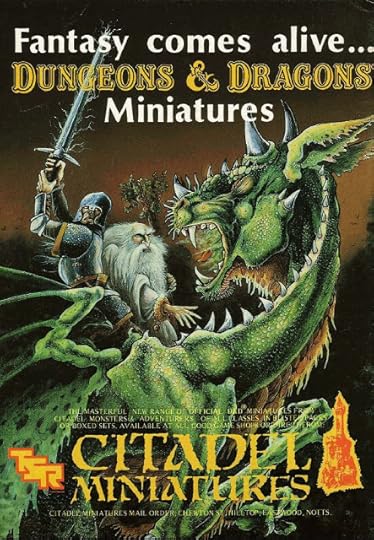
The history of licensed Dungeons & Dragons miniatures is a vast topic in and of itself and one someone with more knowledge than myself really ought to write. Nevertheless, I think the brief eighteen-month period, starting in 1985, when Games Workshop's subsidiary, Citadel Miniatures, held the official D&D miniatures license is an episode well worth examining.
Citadel acquired the licensed immediately after the disastrous two-year period during which TSR made a go at making its own minis. I owned a couple of the TSR boxed sets – one for AD&D and another for Star Frontiers – and can attest to their poor quality. Perhaps they were better received elsewhere, but, among my circle of friends, I think I was the only one who ever bought them and, after a few desultory attempts to paint some of them, they went back in my closet, never to be looked at, let alone used.
It's a testament to the rising power of Games Workshop – and Warhammer Fantasy Battle – that TSR would turn to Citadel to manufacture its miniatures in the aftermath of their own failure in the minis market. From what I gather, these figures were quite good and were notable for, among other things, introducing three-stage player character sculpts, one each for the low, mid, and high levels. Unfortunately, I don't think I ever saw them outside of advertisements; the brief lifespan of the line probably didn't help.
If you owned or made use of the Citadel D&D miniatures, I'd love to read about your memories and impressions of them,
February 28, 2023
Retrospective: Danger at Dunwater
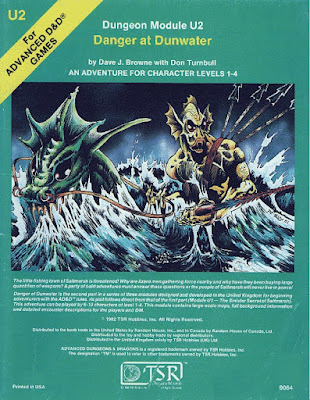 Released in 1982, Danger at Dunwater is the sequel to The Sinister Secret of Saltmarsh and the middle adventure in the trilogy of U-series modules. Indeed, action picks up almost immediately after the events of its predecessor, which makes it quite easy to use at the table. Equally significant is that the module encourages and rewards thoughtful play, just as Saltmarsh did. Writer Dave J. Browne (with assistance from Don Turnbull) is to be commended for having penned another module that is quite unlike anything else being produced for AD&D at the time. The praise that this series of modules has thus received over the years is, in my opinion, quite well deserved.
Released in 1982, Danger at Dunwater is the sequel to The Sinister Secret of Saltmarsh and the middle adventure in the trilogy of U-series modules. Indeed, action picks up almost immediately after the events of its predecessor, which makes it quite easy to use at the table. Equally significant is that the module encourages and rewards thoughtful play, just as Saltmarsh did. Writer Dave J. Browne (with assistance from Don Turnbull) is to be commended for having penned another module that is quite unlike anything else being produced for AD&D at the time. The praise that this series of modules has thus received over the years is, in my opinion, quite well deserved.Danger at Dunwater hinges on some curious clues discovered during the course of the previous adventure. While tangling with the smugglers besetting the town of Saltmarsh, the player characters discover evidence that, in addition to their other illicit activities, the smugglers were selling arms and armor to lizard men. The characters even uncover a map that indicates the location of the lizard men's settlement. Once Saltmarsh's ruling council learns of this information, they become alarmed, assuming that the lizard men, whose settlement is located at the nearby Dunwater River, are preparing to march against them. Alarmed, they ask the PCs to investigate the truth of this and, if necessary, deal with the looming threat to Saltmarsh.
What then follows is a short trek through the marshland in and around the Dunwater, where a few low-level threats lurk, such as giant snakes and bullywugs. However, the bulk of the adventure takes place within the lizard men's fortress. There, the characters encounter a lot of lizard men, who are quite prepared to defend their lair. Among them, the characters also find females and children, in keeping with the generally naturalistic tone of the U-series modules. Of course, this fact might also prick the consciences of all but the most bloodthirsty adventurers – and it is, in fact, supposed to do so.
The central "trick" of Danger at Dunwater is portraying the lizard men not as monsters but as intelligent beings with whom the player characters might parley and from whom they might learn something. If they undertake this course of action, the PCs soon realize that the situation is not as the people of Saltmarsh fear. Yes, the lizard men are arming themselves in preparation for war, but it is not a war against the people of the village. The only reason the lizard men are now occupying this fortress is because they have been driven out of their original home by the evil sahuagin. Now, the lizard men are forming an alliance with other coastal and sea-dwelling races to launch an attack against the sahuagin and reclaim their homes.
This is certainly an unexpected turn of events, or so I recall finding it in 1982. At its start, Danger at Dunwater looks to be yet another low-level module where the characters are tasked with eliminating the encroachment of human lands by monstrous humanoids, as in The Keep on the Borderlands. In reality, it's something quite different, as a conversation with the lizard man chief and his aged advisor soon makes clear. The lizard men originally did not believe humans would be much use in their fight against the sahuagin. After seeing their effectiveness in battle firsthand, perhaps an alliance with them as well might be in order, thereby setting up the action of the third module in the series. Before that can happen, though, the characters must turn over any treasure they took from the lizard men and pay weregild for any lizard men they slew before realizing the truth. How's that for unexpected?
Like The Sinister Secret of Saltmarsh, Danger at Dunwater is a module that turns many Dungeons & Dragons adventure assumptions on their heads. The result can be satisfying, but, even more so than its predecessor, the success of this adventure depends on how quickly the characters recognize that things are not at all what they seem. It's also possible that some players might feel cheated by having the metaphorical rug pulled out from under them, not to mention the loss of treasure (and money) to assure a positive outcome for Saltmarsh. I think that's certainly fair, though it's been my experience that most players enjoy being surprised and Danger at Dunwater offers that in spades.
White Dwarf: Issue #67
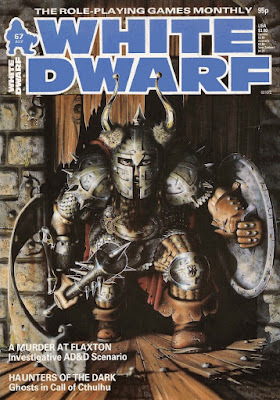 Issue #67 of White Dwarf (July 1985) is one I remember very well, largely for a single article with which I became quite enamored after having read it at the time (more on that soon). Featuring a cover by Mark Bromley, this issue is also fixed in my memory because it was the last issue I received by subscription. I still continued to read the magazine for some time after this, but I never again had a subscription to it. Precisely why I ended my subscription I can't recall; it may have been simple laziness on my part.
Issue #67 of White Dwarf (July 1985) is one I remember very well, largely for a single article with which I became quite enamored after having read it at the time (more on that soon). Featuring a cover by Mark Bromley, this issue is also fixed in my memory because it was the last issue I received by subscription. I still continued to read the magazine for some time after this, but I never again had a subscription to it. Precisely why I ended my subscription I can't recall; it may have been simple laziness on my part. Ian Livingstone's editorial notes that, "after nearly ten years of running a poor second to the USA in the creation of fantasy games ... Britain is quickly catching up." Though intended as a boast – and a bit of self-promotional for Games Workshop's products – there's a great deal of truth in this. By the mid-1980s, the industry leader, TSR, felt like a spent force, even to a fanboy such as I. No other American company ever achieved the same level of success or reach until the '90s, leaving an opening for a new top dog. Warhammer, still on the rise at the time, would soon become the juggernaut it remains today.
The issue's articles begin with the cleverly named "Haunters of the Dark" by Graeme Davis. Over the course of three densely-packed pages, Davis offers up rules and ideas for handling ghosts in Call of Cthulhu. This is the article that made the issue for me in my youth, as I was much impressed not only with the content of the article itself but the possibilities it opened up. In my teen years, CoC was my go-to game for horror. While the game provided some support for non-Mythos adversaries, that was never the focus of the game. This article was a step toward correcting that and I adored it.
"Open Box" opens with a very fair but largely negative review of Pacesetter's Star Ace (5 out of 10), a science fiction game whose mix of ideas never managed to gel. Also reviewed is Monster Coliseum for the Avalon Hill edition of RuneQuest, which fares only slightly better (6 out of 10). Finally, there are reviews for three Dragonlance modules: Dragons of Flame (7 out of 10), Dragons of Hope (8 out of 10), and Dragons of Desolation (9 out of 10). In retrospect, it's quite fascinating to be reminded of just how well received Dragonlance was at the time. While the reviews here are not wholly without criticisms, the overall tone is positive. Though I remain convinced that, on balance, Dragonlance was a net negative for the development of D&D, there really was a hunger at the time for what the Hickman Revolution was offering.
Dave Langford's "Critical Mass" laments the pace at which fantasy and science fiction books are being published – and his own inability to keep pace with reviewing them. Consequently, he decides not even to try, focusing instead on longer reviews of fewer books than one lots of rapid fire bullet point reviews of everything that comes across his desk. Even so, Langford still manages to review slightly more than a half-dozen books in this month's column, which is nothing to sneeze at. The standout is his review of Brian Aldiss's Helliconia Summer, the final book in what Langford calls "an impressive trilogy." I couldn't agree more.
"Loam Wolves" by Barry Atkins is a fun little article that introduces "barbarian" magic to replace standard battle magic in RuneQuest. As its title suggests, the magic takes the form of runes drawn with moist earth upon the body of a barbarian, imbuing him with certain powers for a duration of time. While not mind-blowing by any means, it's a solid, flavorful article of the sort I generally like. "Peking Duck" by Phil Masters is a superhero brawl set in and around a Chinese restaurant, the Fo Yen Wok. Statted for both Champions and Golden Heroes, the article is also notable for the appearance of yet more terrible graphic design choices by the White Dwarf staff. Behold!
 "Worldly Wiles" by Anna Price discusses "social customs in Traveller." It's a fairly innocuous examination of how to flesh out the societies and cultures of new worlds by reference to history and science fiction literature – nothing special. "A Murder at Flaxton" by Michael Heaton, meanwhile, is much more interesting. It's a low-level AD&D scenario set in a seaside town beset by smugglers and slavers, filled with lots of hidden secrets and memorable NPCs. Though the situation presented in the scenario is far from innovative, Heaton handles it well. I think it could serve as an enjoyable kick-off of a new campaign.
"Worldly Wiles" by Anna Price discusses "social customs in Traveller." It's a fairly innocuous examination of how to flesh out the societies and cultures of new worlds by reference to history and science fiction literature – nothing special. "A Murder at Flaxton" by Michael Heaton, meanwhile, is much more interesting. It's a low-level AD&D scenario set in a seaside town beset by smugglers and slavers, filled with lots of hidden secrets and memorable NPCs. Though the situation presented in the scenario is far from innovative, Heaton handles it well. I think it could serve as an enjoyable kick-off of a new campaign."Parlour Game" by Stephen Dudley is a terrific article on a topic I loathe: spiders. The article provides lots of information about the hunting practices of spiders, as well as their use of webs to achieve similar goals. Obviously, not every referee will care about this sort of thing, but, in an adventure that heavily features eight-legged baddies, the additional detail might well be useful. "The Vivimancer" by Steve Palmer introduces a strange new "monster," a bodhisattva-like being returned to the land of the living after death to aid "goodly characters in their struggle against evil." The vivimancer is a powerful healer and foe of undead, demons, and devils. As presented, I suppose it'd be useful as an ally to the PCs rather than as a front-line combatant, which I don't mind (too much).
"The Magic Frame" by Joe Dever and Gary Chalk discusses the ins and outs of photographing miniatures. Specifically, the article talks about the best kinds of cameras and equipment for doing so, which is a topic I'd never really considered before. "Traveling Light" describes a collection of special magical and mundane backpacks, like messenger packs, which teleport items from one backpack to another to which it is connected. I appreciate minor magical items of this sort. The issue also includes further installments of "Thrud the Barbarian," "Gobbledigook," and "The Travellers," as usual. The last one is noteworthy this month, because it not only concludes a long-running storyline, it also does so by recourse to a random dice roll à la 76 Patrons.
As I said at the beginning of this post, this is an issue I remember well. The issues that follow are hazier in my memory, so it will be fascinating to re-read them. I wonder how much of their content will seem genuinely new to me and how much I'll begin to recall once I've had the chance to peruse them again.
February 27, 2023
The Long Haul
I ended my recent review of The Spinward Extents for the Mongoose edition of Traveller by noting that reading the book "left me wanting to start a campaign in this region of space" and I meant that. Over the past few days, I've felt a powerful lust for doing just this. It's a feeling I haven't felt in a while, in large part, I imagine, because I'm already refereeing two ongoing campaigns: House of Worms for Empire of the Petal Throne and Barrett's Raiders for Twilight: 2000. Though I don't post about them all that often, they're both going strong and I don't anticipate either one of them ending anytime soon.
It's been general experience that having an ongoing, regularly-played – preferably weekly – campaign is a surefire inoculation against the ravages of "gamer attention deficit disorder." For as long as I've been involved in the hobby, gamer ADD has been a great scourge, one that's only become more insidious as the number of roleplaying games available has increased. In my youth, there were only so many RPGs and thus the temptation to abandon one and pick up another was not as great as today. The present age, though, is blessed (or cursed, depending on your point of view) with a surfeit of RPGs about every conceivable subject matter, thereby increasing the temptation to take up with one of them, despite already playing another.
I've mentioned this desire to start up a Traveller campaign to others and they've been little help in steeling my resolve against it. "Go for it," they say, "you've got the time to referee another campaign, don't you?" Others tell me, "Traveller is your favorite RPG. Why wouldn't you want to start up a campaign? It'll be fun." This is all true. I do love Traveller and I do have the time. Despite this, my will is unyielding, my resistance remains strong and for a very simple reason: I initiate every campaign with the expectation that it will last for years. If I don't feel confident that I can achieve that, I don't see much point in refereeing.
I am very committed to long campaigns. Certainly, not all of my campaigns have succeeded in lasting multiple years and indeed many of them have not lasted even a single year. Yet, that remains my ideal, the thing I hope for every time I decide to invite people to join me in playing a RPG. Anything less than that feels frivolous and simply not worth my time. I'm of an age where I have no interest in flitting like a butterfly from one game to the next. I want to put a campaign properly through its paces, exploring every inch of it with my players and, in my opinion, that can only be done by devoting years to the endeavor. Anything less holds little appeal to me.
Refereeing a long campaign lasting years isn't something one can do casually. It demands not just time but dedication on the part of both the referee and the players. This is, in my experience, not always easy, especially at this present moment in history when distractions abound and compete for our attention. The perseverance required to stick with a single RPG and play it loyally sometimes seems to be in short supply. This is why I considered myself particularly blessed in having not one but two groups of players who show up week after week to play in my campaigns (though there is, to be fair, considerable overlap between the two groups).
So, for the time being, refereeing a Traveller campaign will have to wait – and that's fine.
James Maliszewski's Blog
- James Maliszewski's profile
- 3 followers



